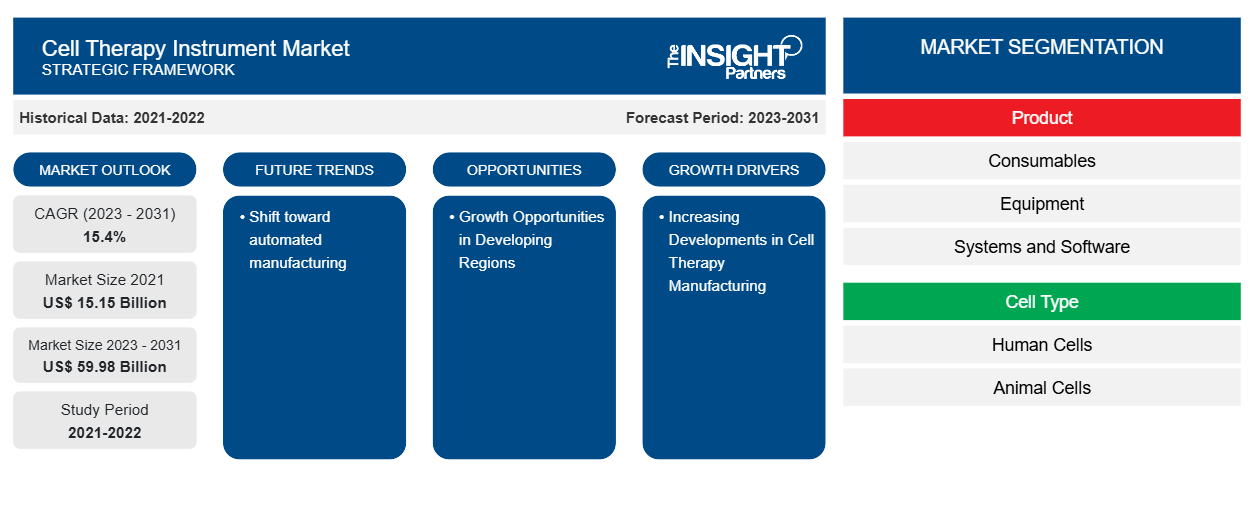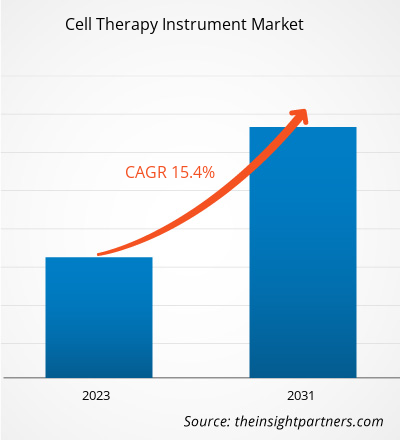The cell therapy instrument market was valued at US$ 15.15 billion in 2021 and is expected to reach US$ 59.98 billion by 2031. The market is expected to register a CAGR of 15.4% in 2023–2031. Shift toward automated manufacturing will likely remain a key cell therapy instrument market trend.
Cell Therapy Instrument Market Analysis
Cell therapy is when living and intact cells are injected, implanted, or grafted into the patient's body. For instance, a person with cancer is injected with T cells during their course of immunotherapy. Delivery of cell therapy instruments ranges from injections to surgical implantation using special devices. Cell therapy has applications in a large number of disorders. The most important diseases of the nervous system are cancer. Other applications include cardiac conditions (myocardial infarction and heart failure), diabetes mellitus, bones and joints, genetic disorders, and wounds of the skin and soft tissues.
Cell Therapy Instrument Market Overview
One of the most promising methods for treating cancer is chimeric antigen receptor (CAR) T-cell therapy, and every year, an enormous number of pre-clinical and clinical trials are conducted to increase its application. After decades of research, CAR-T cell therapy will inevitably expand. In addition to autologous and allogeneic products, new in-vivo CAR-T cell gene therapies and efficacy in indications other than hematologic malignancies will also be investigated in the future of cellular therapies.
Customize This Report To Suit Your Requirement
You will get customization on any report - free of charge - including parts of this report, or country-level analysis, Excel Data pack, as well as avail great offers and discounts for start-ups & universities
Cell Therapy Instrument Market: Strategic Insights

-
Get Top Key Market Trends of this report.This FREE sample will include data analysis, ranging from market trends to estimates and forecasts.
Cell Therapy Instrument Market Drivers and Opportunities
Increasing Developments in Cell Therapy Manufacturing
The increasing research activities in cell therapy have led to extraordinary therapeutic developments in cell therapy instruments to treat genetic disorders and improve the immune system efficiently. Various market players provide consumables such as reagent kits and enzymes, and many companies offer instruments, equipment, and software to conduct a wide range of cell therapy processes.
Equipment use is important for producing cell therapies such as T cells, HSC, MSC, PSC, and NSC. These cell therapy products are derived from human or animal cells and thus require safe conditions from contamination. Thus, the instruments used for cell therapies help prevent contamination and allow scaling up the production. For instance, companies such as Corning Incorporated, Hitachi Chemical Advanced Therapeutics Solutions, LLC, Cytiva (General Electric Company), Thermo Fisher Scientific Inc., Invetech, and Miltenyi Biotec have introduced various instruments and consumables for cell therapy.
Growth Opportunities in Developing Regions– An Opportunity in the Cell Therapy Instruments Market
The biotechnology sector in Asia Pacific and Middle East is growing rapidly with the support of heavy investments and strategic developments among private and public organizations with countries in North American and European regions. For instance, in December 2019, Astellas Pharma Inc (Japan) signed an agreement to acquire Audentes Therapeutics Inc., a gene therapy company, for US$ 3 billion. Similarly, in November 2019, Fujifilm planned to invest ~US$ 120 million (13 billion yen) in gene therapy as a part of contract development and manufacturing segment of the organization. Also, the Japan Pharmaceutical Medical Device Agency (PMDA) approved two gene therapy products. The products were approved simultaneously under Sakigake designation, which is equivalent to the FDA breakthrough therapy designation and the EMA Priority Medicine (PRIME) designation and is expected to approve at least one therapy per year. Such strategic developments by the domestic players in the Asian countries for cell therapy domain are likely to increase demand for cell therapy instruments in coming future.
Cell Therapy Instrument Market Report Segmentation Analysis
Key segments that contributed to the derivation of the cell therapy instrument market analysis are disorder and service providers.
- Based on products, the cell therapy instrument market is segmented into consumables, equipment, systems and software. The consumables segment held a larger market share in 2023.
- By cell type, the cell therapy instrument market is segmented into human cells, animal cells. The thermoplastics segment held the largest share of the market in 2023.
- By process, the cell therapy instrument market is segmented into cell processing, process monitoring and quality control, cell preservation, distribution, and handling. The cell processing segment held the largest share of the market in 2023.
- By end users, the cell therapy instrument market is segmented into research institutes, life science research companies, other end users. The life science research companies segment held the largest share of the market in 2023.
Cell Therapy Instrument Market Share Analysis by Geography
The geographic scope of the cell therapy instrument market report is mainly divided into five regions: North America, Asia Pacific, Europe, Middle East & Africa, and South America/South & Central America.
The US is the largest and fastest-growing market for cell therapy instruments. The market growth is attributed to increased R & D and the growing adoption of cell therapies such as gene, stem cell, and immune therapies. In addition, increasing support from the government is enhancing the growth of cell therapies, influencing the market's growth. For instance, the American Society of Gene & Cell Therapy (ASGCT), a public organization, provides memberships to scientists, physicians, professionals, and patient advocates engaged in gene and cell therapies. ASGCT aims to enhance knowledge, education, and awareness regarding the clinical application of cell and gene therapies.
Cell Therapy Instrument Market Regional InsightsThe regional trends and factors influencing the Cell Therapy Instrument Market throughout the forecast period have been thoroughly explained by the analysts at The Insight Partners. This section also discusses Cell Therapy Instrument Market segments and geography across North America, Europe, Asia Pacific, Middle East and Africa, and South and Central America.
Cell Therapy Instrument Market Report Scope
| Report Attribute | Details |
|---|---|
| Market size in 2021 | US$ 15.15 Billion |
| Market Size by 2031 | US$ 59.98 Billion |
| Global CAGR (2023 - 2031) | 15.4% |
| Historical Data | 2021-2022 |
| Forecast period | 2023-2031 |
| Segments Covered |
By Product
|
| Regions and Countries Covered |
North America
|
| Market leaders and key company profiles |
|
Cell Therapy Instrument Market Players Density: Understanding Its Impact on Business Dynamics
The Cell Therapy Instrument Market is growing rapidly, driven by increasing end-user demand due to factors such as evolving consumer preferences, technological advancements, and greater awareness of the product's benefits. As demand rises, businesses are expanding their offerings, innovating to meet consumer needs, and capitalizing on emerging trends, which further fuels market growth.

- Get the Cell Therapy Instrument Market top key players overview
Cell Therapy Instrument Market News and Recent Developments
The cell therapy instrument market is evaluated by gathering qualitative and quantitative data post primary and secondary research, which includes important corporate publications, association data, and databases. The following is a list of developments in the market for foot orthotic insoles:
- Thermo Fisher Scientific and robotics expert Multiply Labs signed an agreement to further their collaboration to automate cell therapy production. (Source: Thermo Fisher Scientific, 2024).
- To provide a unified technological platform for next-generation cellular therapies from concept to commercialization, MaxCyte launches the ExPERT instrument family. (Source: MaxCyte, Press Release, 2019).
Cell Therapy Instrument Market Report Coverage and Deliverables
The “Cell Therapy Instrument Market Size and Forecast (2021–2031)” report provides a detailed analysis of the market covering below areas:
- Market size and forecast at global, regional, and country levels for all the key market segments covered under the scope
- Market dynamics such as drivers, restraints, and key opportunities
- Key future trends
- Detailed PEST/Porter’s Five Forces and SWOT analysis
- Global and regional market analysis covering key market trends, major players, regulations, and recent market developments
- Industry landscape and competition analysis covering market concentration, heat map analysis, prominent players, and recent developments
- Detailed company profiles
- Historical Analysis (2 Years), Base Year, Forecast (7 Years) with CAGR
- PEST and SWOT Analysis
- Market Size Value / Volume - Global, Regional, Country
- Industry and Competitive Landscape
- Excel Dataset
Recent Reports
Related Reports
Testimonials
Reason to Buy
- Informed Decision-Making
- Understanding Market Dynamics
- Competitive Analysis
- Identifying Emerging Markets
- Customer Insights
- Market Forecasts
- Risk Mitigation
- Boosting Operational Efficiency
- Strategic Planning
- Investment Justification
- Tracking Industry Innovations
- Aligning with Regulatory Trends





















 Get Free Sample For
Get Free Sample For